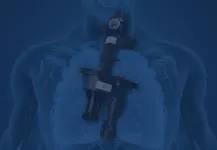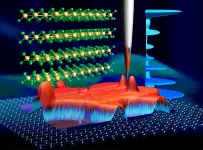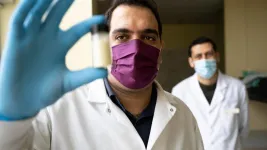(Press-News.org) The design, testing, and validation of the Illinois RapidVent emergency ventilator has been published in the journal Plos One. The article, "Emergency Ventilator for COVID-19," by University of Illinois Urbana researchers, is the first of its kind to report such details about an emergency ventilator that was designed, prototyped, and tested at the start of the COVID-19 pandemic in 2020.
"This article reports the development and testing of the RapidVent emergency ventilator," said William King, professor at The Grainger College of Engineering and Carle Illinois College of Medicine, and leader of the RapidVent project. "The research shows integration of different disciplines to develop a medical device, including science-based engineering, ultra-rapid design and manufacturing, functional testing, and animal testing."
The Grainger College of Engineering, Carle Illinois College of Medicine, and industry partners launched the Illinois RapidVent project to address ventilator shortages in spring 2020. The goal was to design an emergency ventilator that could be rapidly and inexpensively produced.
"Publication of this work helps to share our knowledge with the public and acknowledge the outstanding intellectual contributions of our team members," said King Li, Dean of the Carle Illinois College of Medicine.
The RapidVent team consisted of more than 50 people who worked together to develop an emergency ventilator in less than three weeks. The Illinois RapidVent is easy to produce in part because it has few components and can be powered from pressured air or oxygen.
"The rapid development and successful delivery of the functional Illinois RapidVent is yet another amazing display of collaborative interdisciplinary research, and a testament of what can be achieved here at Illinois for our community, society, and global health," said Stephen Boppart, Executive Associate Dean and Chief Diversity Officer of Carle Illinois College of Medicine. "It's a primary example of how engineering- and technology-based medicine can support the land-grant mission of our university. The team members from Carle Illinois College of Medicine were proud to help catalyze this effort."
"Emergency Ventilator for COVID-19" reports how the team developed their ventilator design based on the needs of physicians. The team then used digital design and advanced manufacturing for ultra-rapid development of prototypes, followed by detailed functional testing, durability testing, and animal testing.
To support safe use of the device, the team also developed an electronic monitoring system and detailed training materials that can be used by physicians. The monitoring system became Illinois RapidAlarm, an open-source sensor and alarm system that makes emergency ventilators, such as the Illinois RapidVent, more useful during a crisis.
"The RapidVent team built upon relationships forged through Carle Illinois College of Medicine. This focus on engineering and medicine is the exact vison we shared - one that would generate practical solutions to healthcare opportunities and challenges," said Dr. Mark Johnson, Carle Health physician and RapidVent team member.
The University of Illinois made the RapidVent technology available through a free license in April 2020. The license includes access to device designs, training materials, and a testing report. Since then, more than 70 organizations have accessed the technology from 15 different countries. There are multiple efforts underway to make use of RapidVent, including two companies that have announced their intention to commercialize the technology.
INFORMATION:
The article is available online:
https://doi.org/10.1371/journal.pone.0244963
More information about the project is available at https://rapidvent.grainger.illinois.edu
The 55 co-authors on the article include:
William P. King, Jennifer Amos, Magdi Azer, Daniel Baker, Rashid Bashir, Catherine Best, Eliot Bethke, Stephen A. Boppart, Elisabeth Bralts, Ryan M. Corey, Rachael Dietkus, Gary Durack, Stefan Elbel, Greg Elliott, Jake Fava, Nigel Goldenfeld, Molly H. Goldstein, Courtney Hayes, Nicole Herndon, Shandra Jamison, Blake Johnson, Harley Johnson, Mark Johnson, John Kolaczynski, Tonghun Lee, Sergei Maslov, Davis J. McGregor, Derek Milner, Ralf Moller, Jonathan Mosley, Andy Musser, Max Newberger, David Null, Lucas O'Bryan, Michael Oelze, Jerry O'Leary, Alex Pagano, Michael Philpott, Brian Pianfetti, Alex Pille , Luca Pizzuto, Brian Ricconi, Marcello Rubessa, Sam Rylowicz, Clifford Shipley, Andrew C. Singer, Brian Stewart, Rachel Switzky, Sameh Tawfick, Matthew Wheeler, Karen White, Evan M. Widloski, Eric Wood, Charles Wood, and Abigail R. Wooldridge
Previously controversial values of the energy gap of a van der Waals material -- chromium tribromide -- were reported based on various optical measurements. A University of Wyoming faculty member and his research team used scanning tunneling microscopy and spectroscopy measurements that clearly reveal a much smaller energy gap value and resolved the controversy.
"Our results settled a long controversy on one important material property -- the energy gap of the material," says TeYu Chien, an associate professor in the UW Department of Physics and Astronomy. "Our scanning tunneling microscopy and spectroscopy measurements clearly revealed that the energy gap is around 0.3 electron volt (eV), which is much smaller than those measured by optical ...
Nearly every galaxy hosts a monster at its center -- a supermassive black hole millions to billions times the size of the Sun. While there's still much to learn about these objects, many scientists believe they are crucial to the formation and structure of galaxies. What's more, some of these black holes are particularly active, whipping up stars, dust and gas into glowing accretion disks emitting powerful radiation into the cosmos as they consume matter around them. These quasars are some of the most distant objects that astronomers can see, and there is now a new record for the farthest one ever observed.
A team of scientists, led by former UC Santa Barbara ...
What's the relationship between money and well-being? "It's one of the most studied questions in my field," says Matthew Killingsworth, a senior fellow at Penn's Wharton School who studies human happiness. "I'm very curious about it. Other scientists are curious about it. Laypeople are curious about it. It's something everyone is navigating all the time."
To answer this question, Killingsworth collected 1.7 million data points from more than 33,000 participants who provided in-the-moment snapshots of their feelings during daily life. In a paper in the Proceedings of the National Academy of Sciences, Killingsworth confirms that money does influence happiness and, contrary to previous influential research on the subject suggesting that this plateaus above ...
'What goes in, must come out' is a familiar refrain. It is especially pertinent to the challenges facing UBC researchers who are investigating methods to remove chemicals and pharmaceuticals from public water systems.
Cleaning products, organic dyes and pharmaceuticals are finding their ways into water bodies with wide-ranging negative implications to health and the environment, explains Dr. Mohammad Arjmand, an assistant professor of mechanical engineering at UBC Okanagan.
And while pharmaceuticals like a chemotherapy drug called methotrexate can be highly effective ...
The team led by Professor Rolf Heumann, Senior Researcher for Molecular Neurobiochemistry at RUB, is hoping that this will allow the effects of neurodegenerative diseases such as Parkinson's to be alleviated over the long term. The results of the work were published on 31 December 2020 in the journal Scientific Reports.
Neurites do not know the way
Restoring brain function following an injury or due to neurodegenerative diseases remains an unresolved problem in neuroscience and medicine. Regeneration in the central nervous system is only possible to a very limited ...
Durable, high-performing perovskite solar cells also require durable, high-performing charge-transporting layers. Scientists have developed the first organic hole transporter that does not need a dopant to attain high charge mobility and stability. According to the study published in the journal Angewandte Chemie, this novel hole-transporting layer outperforms reference materials and protects the perovskite organic cell from air humidity.
In perovskite solar cells, the perovskite light absorption layer is sandwiched between two charge-transporting layers, which collect the generated holes and electrons and transport them to the electrodes. These charge transportation ...
ATLANTA - JANUARY 19, 2021 - Despite increases in overall suicide rates in the United States during the past two decades, cancer-related suicides declined by 2.8% per year, according to a new study by the American Cancer Society. The study, appearing in JNCI: The Journal of the National Cancer Institute, found that the largest declines in cancer-related suicide rates were among high-risk populations, suggesting an evolving role of psycho-oncology and palliative and hospice care for cancer patients and survivors during this period.
To examine the trends in cancer-related suicides compared to overall suicides in the U.S., investigators led by Xuesong Han, PhD, calculated average annual percentage change of suicide rates stratified by risk factors including ...
Just like on Earth, water on other planets, satellites, and even comets comes in a variety of forms depending on multiple factors such as pressure and temperature. Aside from the gaseous, liquid, and solid states we are accustomed to, water can form a different type of crystalline solid called clathrate hydrate. Although they look similar to ice, clathrate hydrates have actually small water-based cages in which smaller molecules are trapped. These trapped "guest" molecules are essential for preserving the crystalline structure of clathrate hydrates, which would otherwise "collapse" into regular ice or water.
Clathrate hydrates play a crucial role in the evolution of a planet or satellite's ...
Washington, DC - January 19, 2021 - Viral genome sequencing of wastewater can detect new SARS-CoV-2 variants before they are detected by local clinical sequencing, according to a new study reported in mBio, an open-access journal of the American Society for Microbiology. The ability to track SARS-CoV-2 mutations in wastewater could be particularly useful for tracking new variants, like the B.1.17 strain that is now widespread in the U.K. and has already been introduced in the U.S.
"SARS CoV-2 virus is excreted by individuals that are infected by COVID -19and the fecal waste ends up in the wastewater systems. By sampling wastewater, we can get information on infections for a whole population. Some wastewater systems serve several thousand people. ...
A small pilot study suggests that early administration of ivermectin can reduce viral loads and symptom duration in patients with mild COVID-19, which in turn could help reduce viral transmission. The study, which is part of the SAINT project and has been led by the University of Navarra Clinic and the Barcelona Institute for Global Health (ISGlobal), an institution supported by the "la Caixa" Foundation, warrants further exploration in larger clinical trials. The findings of the pilot study have been published in EClinicalMedicine, a clinical journal published by The Lancet.
We ...




